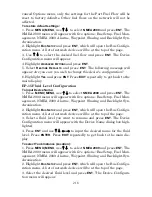
211
The Device Data for an EP-10 Fuel Flow includes Fuel Rate (amount of
fuel burned per hour), Fuel Used, Trip Fuel Used and Seasonal Fuel
Used.
NOTE:
If, as in the graphic above, you do not have a Suzuki Engine Inter-
face, EP-15 Fluid Level or EP-10 Fuel Flow on the network, the
Engine & Configuration menu, Tank Select menu, Tank Size dialog
and Set Configuration button will not be displayed on the Bus Con-
figuration menu.
Fuel Management Menu
The Fuel Management menu gives you access to the following options:
Tank Location, Fuel Added, Add Fuel, Fill Tank, Engine Select, Reset
Calibration, Reset Trip and Reset Seasonal. Those options allow you to
configure, calibrate, reset calibration, reset trip fuel and reset seasonal
fuel for select NMEA 2000 devices. We will cover configuration and cali-
bration procedures later in this section.
Fuel Management highlighted on the NMEA 2000 menu (left).
Fuel Management menu (right).
Tank Location
If you chose an engine-tank configuration with more than one tank, you
will be able to switch the tank location (configuration) in the Tank Lo-
cation menu. When fuel is added to a tank, you will select the correct
tank from the Tank Location menu, then input the amount of fuel
added in the Fuel Added dialog box.
Fuel Added
Used in tandem with the Add Fuel command, the Fuel Added dialog
box allows you to input the amount of fuel added to the tank, when an
amount of fuel is added that does not fill up the tank.
Summary of Contents for LMS-520C
Page 10: ...viii Notes ...
Page 22: ...12 Notes ...
Page 56: ...46 Notes ...
Page 114: ...104 Notes ...
Page 202: ...192 Notes ...
Page 216: ...206 Notes ...
Page 246: ...236 Notes ...
















































